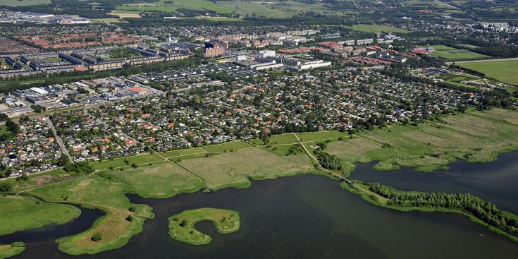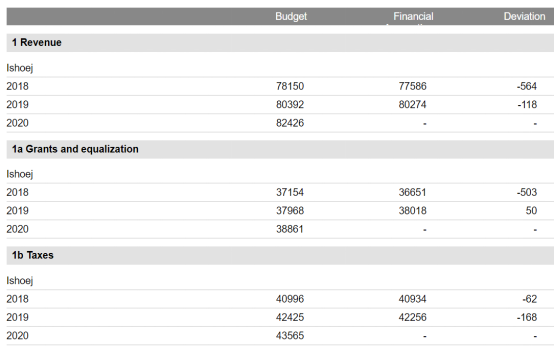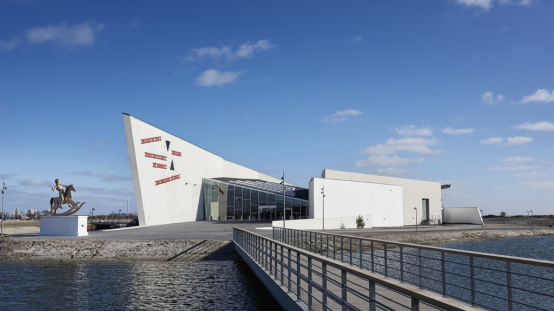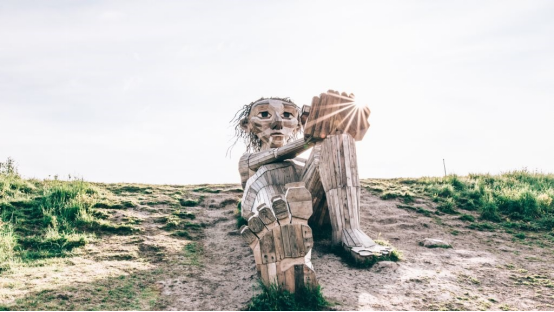Ishøj,Denmark 作者: 来源: 发布时间:2021-06-19
一、人口,面积,所属地区
Population: 22,989
Area: 25.9 km²
Municipality in Hovedstaden

二、自然地理(或者地理环境、自然资源、交通情况)
Ishøj Municipality is a municipality in Region Hovedstaden on the island of Zealand (Sjælland) in eastern Denmark. The municipality covers 26 km² , many of whom are Pakistani, African, Arab, or Turkish immigrants.
The main town, and the site of the municipal council, is the town of Ishøj, which has one of Scandinavia's biggest housing projects - Vejleåparken (formerly Ishøjplanen). More than 76% of the people living there are immigrants or have immigrant parents. Consequently, Ishøj has many nicknames, for instance such as Istanhøj (a merge between the names Istanbul and Ishøj). The town is by the coast in the southwestern suburban area of Copenhagen and is part of the city's urban area.
Neighboring municipalities are Vallensbæk to the east, Høje-Taastrup to the north and west, and Greve to the south.
Ishøj is a modern municipality in growth. The modern Ishøj is seen around Ishøj City Center. Here there are streets and squares with town halls, shops and eateries of all kinds. The old Ishøj can be seen in the villages of Torslunde, Tranegilde and Ishøj Village. Here there are thatched houses, old churches and burial mounds.
Ishøj is a green municipality with wetlands, fields and forest of more than 75 percent of the area. Ishøj is the town by the beach with marina, campsites and lakes. Ishøj is a multicultural city with many nationalities, a vibrant musical life and unique museums. And Ishøj is Vestegnens educational city with young people flocking to the high school, business school or technical school.
Transport
Getting to and from Ishøj is easy. The S-train stops at the station nine times an hour. Direct access to the motorway. And on 37 kilometers of protected bike paths, children, young people and the elderly can travel safely and safely throughout the municipality.
三、经济发展和规模
An increasing number of companies and citizens are choosing to move to Ishøj. Housing is being built, the business area is expanding and unemployment is falling. Ishøj is a growing municipality.

*All amounts are in DKK per. per capita in current prices
四、产业特点重点项目
Ishøj is developing on many fronts these years. On the housing front, more new sites are being built and several projects are underway to create space for 25,000 citizens by 2025, which was part of Ishøj City Council's vision in the plan strategy 2016-2028. However, not only needs to be built - the new homes and residential areas must also reflect the diversity that Ishøj's citizens represent.
Among the larger development areas there is the continued transformation of the Small Business Area (Klimaparken), housing and public purposes in an expanded urban core (overall plan) and development with village character Ishøj Village. In addition, the upcoming light rail in Ring 3 as well as changes in Fingerplan 2019 has enabled a city development around the new station at Ishøj Strand / ARKEN for, among other things, housing purposes. No framework is set for the development of this municipal plan, since a comprehensive plan for the area must first be drawn up.
In the coming planning period, up to 530 housing units are expected to be built according to local plans, which have either been adopted or initiated per year. January 1, 2020. In addition, the municipal plan contains frameworks that allow local planning for an additional 50,000 square meters in Klimaparken - the transformation area at Ishøj Strandvej.
In addition, the municipal plan identifies potential urban development areas totaling 93,200 square meters, which has been made possible partly in connection with the municipality's acquisition of a former educational institution and partly as a result of the Finger Plan.
The conversion area - Klimaparken
'The Little Business Area' was designated as a transformation area in the Municipal Plan 2014. A comprehensive plan for the area was adopted in 2015, where principles were laid down that ensure the overall development of the area, rather than a point-by-step planning in individual local plans. The development of the area must give new dynamism, strengthen the area's qualities and create coherence across the city. The climate park with its stationary location offers good opportunities for urban densification and the transformation is in full swing.
Eagle's Wing
The development of a residential area at Ørnekærs Vång will create opportunities for a new, exciting and attractive housing construction in Ishøj. The development area is about 20,000 m2 and is located next to the regional outdoor area Lille Vejleå. The development of the area has been made possible as a result of the adoption of Finger Plan 2013. A local plan must be prepared for the area, which will determine, among other things, the use for residential area, the nature and size of the buildings, the requirements for low energy and any other climate measures.
Urban development around new light rail station
With the revision of Finger Plan 2017, the City Council has pointed to future urban development opportunities, including the area around the new light rail station at Strandparksstien. The area around the light rail station is centrally and attractive between the city and the coast. In accordance with the station proximity principle, which designates densification possibilities in 600-1200 m. Around stations, it is possible to develop urban in this area.
Brohuset
Centrally located in Ishøj, close to the city center and the station, lies the municipality's newest development area. It has a great potential both in terms of expanding the city center and being able to create recognition. The location creates an opportunity to build attractive, stationary owner-occupied housing, which contributes to the City Council's ambition for mixed housing in Ishøj.
Arkenwalk
The purpose of the new 2.2 km long trail is to better connect Ishøj as a nature and art city and at the same time make it easier for ARKEN's over 300,000 annual guests to find from Ishøj Station to the art museum. The trail will begin at Ishøj Station and snake through both a densely-packed station area, a lively residential area, a dark tunnel, a quiet residential neighborhood and a scenic beach park with meadow and lakes.
ARKENWALK is expected to be inaugurated in 2021.
五、风景名胜,景点
ARKEN Museum of Modern Art
Address: Skovvej 100, 2635 Ishøj
ARKEN Museum of Modern Art in Ishøj, south of Copenhagen, boasts exhibitions with the greatest Modernist artists alongside exhibitions of contemporary art - from new, young talent to established artists.
ARKEN is a great and monumental building situated in the artificial landscape, Køge Bay Beach, a short drive or train ride south of Copenhagen. The museum has one of Scandinavia's finest collections of contemporary art, and the museum's maritime architecture with the pointed stern, which majestically protrudes into the terrain, has won recognition both at home and abroad since its inauguration in 1996.
ARKEN's collection contains more than 400 works - Danish, Nordic and international contemporary art primarily from the period after 1990. The museum houses, among other things one of Europe's most important collections of the British artist Damian Hirst.
The museum building is an attraction in itself. Designed by architect Søren Robert Lund, it portrays a stranded ship a few metres from the beach. The museum is located in scenic surroundings between Ishøj Harbour and the long sandy beach, so a visit to the museum is not complete without a walk.
The museum café hangs like a lifeboat on the side of the building and through the large panoramic windows overlooks Køge Bay.
The museum shop is the area's leading design shop with an inspiring mix of Nordic design, art books and gift items.

The Six Forgotten Giants
Address: Several locations, 2635 Ishøj
Scattered around lush forests, meadows and by calm waters in suburbia Copenhagen, you'll meet the tall, quirky-looking wooden sculptures which are pretty far from your typical tourist attraction.
The six municipalities of the greater Copenhagen region which are homes to the impressive art pieces are definitely off the beaten track. And that's exactly why artist, Thomas Dambo opted for these scenic settings locations for his sculptures built from recycled woods; to get locals out discovering and enjoying nature. You are of course invited to do the same.
Perfect for families who want to go beyond the usual touristy sights and attractions to enjoy nature, finding your way to the giants are a fun activity for older kids. Especially if you or your kids like that treasure hunt feeling.

六、历史文化
Ishøj Municipality was established in 1842 under the name Torslunde-Ishøj Parish. Back then, the municipality consisted of Torslunde parish with the village of Torslundemagle and Ishøj parish with the villages of Ishøj and Tranegilde. After the large expansion in connection with the Køge Bay plan, the municipality changed its name to Ishøj in 1975.
The development of Ishøj was part of the Køge Bay plan. The planning was to secure well-planned suburbs for Copenhagen and the initiative was initiated with the Køge Bay Act of 1961. The law took a planned basis in the Finger Plan and the extension of the S-train line to Køge. The Køge Bay plan was an ambitious plan for a new growth area for 150,000 people. Based on the plan, the municipalities subsequently prepared retail plans that were in time in line with the development of the railway and the road network. The nine S-train stations from Avedøre to Jersie were to form new centers for new cities with 10,000-20,000 inhabitants.
Generally for the development, the density of buildings was greater near the stations, that the detached houses were located close to the beach and the business areas separate from the residential areas. The population of Ishøj increased enormously with the increase. In 1965, 3,000 lived in Ishøj and by 1979 it had increased to about 20,500, which is roughly equivalent to today's population. Most of the public and private services are located in Ishøj City Center, located at the station.
In 1980, Ishøj Strandpark was inaugurated as part of Køge Bugt Strandpark, which helped to give the whole coastline a positive boost. The beach park is an artificial planned coastline located 400-500 meters in front of the original. Køge Bay Beach Park contains 7 km of sandy beach, of which about 2.5 km in Ishøj. The beach park has led to many local improvements, including for water quality and storm surge protection in the low-rise detached houses. Furthermore, Strandparken has developed into an important breeding and rest area for a wide range of bird species of ornithological interest.
Strandparken is a versatile leisure area with beach, large green areas, marina and water sports clubs. In 1996, Strandparken also got a cultural attraction with the opening of ARKEN, the Museum of Modern Art.
Many of the newcomers in the 1970s were young families with children. Today, the population composition is very mixed. Now there are approximately 23,000 inhabitants in the municipality.
Historically, Ishøj traces back to the Bronze Age. One of Ishoj's two preserved burial mounds contained an ancient grave age coat of arms. At Torslunde Mark a rich tomb from the younger Roman Iron Age was found, including Roman glass and bronze vessels.
Ishøj Municipality was not merged with other municipalities by January 1, 2007 as the result of nationwide Kommunalreformen ("The Municipal Reform" of 2007).
Ishøj is a multicultural city with many nationalities, a burgeoning music life and have a unique world-class art museum. Ishøj is the City of Art with ARKEN in Strandparken and ARKENWALK, which will be realized over the next few years. ARKENWALK becomes the art trail that guides visitors on their way via a fantastic two-kilometer route from the station square to the museum.
The Municipality are further developing the variation in green and blue areas. Nowhere is more than a mile to the larger recreational and green areas. Both the rivers, the beach park, the newly planted forest and the open plains to the west, where the villages and manor landscapes are, offer a wealth of different nature experiences and leisure pursuits.
七、联系方式
Mayor: Ole Bjørstorp
Address: Ishøj Store Torv 20, 2635 Ishøj
Telephone: 43577575
mail: ishojkommune@ishoj.dk
Facebook: https://www.facebook.com/ishojkommune
Website: https://ishoj.dk/
